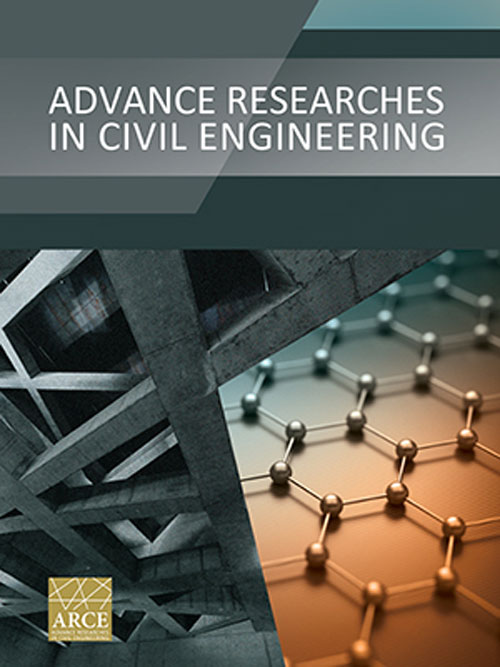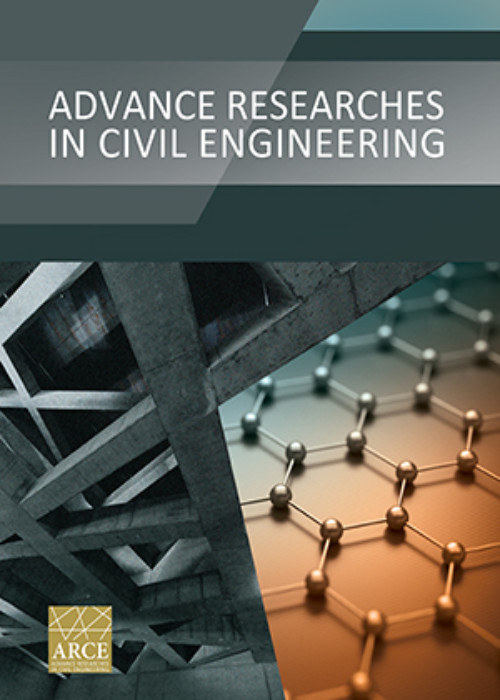فهرست مطالب

Advance Researches in Civil Engineering
Volume:2 Issue: 2, Spring 2020
- تاریخ انتشار: 1399/04/02
- تعداد عناوین: 6
-
Pages 1-14
To investigate the effects of crude oil leakage on silty sand soil, a functional device was set up; it is highly similar to column test. Some factors were altered during tests such as time leakage, porosity, and water content. Direct shear and permeability tests have been also done on contaminated soil and the curves of tests results were extracted by Taguchi method and Minitab software. This method could present the effects of each factor on internal friction angle, cohesion and permeability separately. Results indicate that by increasing the time leakage, shear strength parameters raised while permeability considerably reduced. Furthermore, with increase in porosity of soil samples, the values of shear parameters were decreased while permeability was increased. The only factor which has brought a positive impact to shear strength parameters is water content; because this factor has fallen permeability and improved the shear parameters. Taguchi method is the most effective method to investigate the behavior of contaminated soil, which can be used in other related studies.
Keywords: Crude Oil, Contaminated Soil, Permeability, Shear strength, Taguchi design method -
Pages 15-23
Today, tall structures are the most dominating symbol of the cities. The tall structures should be design for strength against gravity and lateral loads, stiffness, ductility and system efficiency. Ever increasing number of stories, height to depth ratio and complexity of form, need for robustness coupled to economy, awareness of limited material resources and sustainability, are all new demanding questions to be tackled with fresh approaches, novel structural systems. Modern structural system provides significant progress in establishing the necessary flexibility in design. In this study, a numerical study is conducted to estimate the seismic performance of horizontal hexagrid structural and diagrids systems. To this end, two models of twenty-story steel structures were designed. The models with horizontal hexagrid cells which transited to vertical cells using a transitional story, and a model of the diagrid system have been designed by using SAP2000 software. Also, nonlinear dynamic analyses are performed on buildings. Results indicate that roof displacement of the horizontal hexagrid structural system under nonlinear dynamic analyses is less than the diagrid structure. Also, there is no difference between the two systems for maximum drift at first floor, but increasing height, the drift values of the hexagrid structural system are less than the diagrid system. According to the results, the tall structure with a hexagrid structural system performs better than the diagrid system against earthquakes.
Keywords: Tall building, nonlinear static, dynamic analysis, Hexagrid System -
Pages 24-30
Water Tanks are amongst the most important structures which are used for storage and providing the water needed on the pick usage time in water supply networks. The Seismic behaviour of such special structures is the main objective of current research, which was motivated by raising demands for design and construction of elevated water tanks. Hence, two structural models of steel elevated water tanks in Armneia, with capacities of 134m3 and 160m3, demonstrating a height of 24m and 30m respectively are selected as shown in Figure 1. Each model is considered to be empty, 50% and 100% full and is designed according to Armenian SNIP II-6.02 seismic code for all filling strategies, taking into account the spectral acceleration level equal to Sa=0.40g. On each model, the information of Convective mass, Impulsive mass and the spring stiffness of the convective and impulsive masses are added, due to the Housner’s Equivalent Mass-Spring theory, considering Soil-Structure Interaction (SSI) effects at the meantime. Earthquake Analysis procedures of the whole fluid-tank systems are completed by the means of Time History Analysis method, using 3 horizontal components of selected accelerograms, recorded on soil categories of Rock, Dense Soil and Loose Soil respectively, scaled to spectral acceleration levels of Sa=0.2g ~1.0g. Finally, the seismic response is computed for the filling strategy of Empty, 50% full and 100% full conditions for both models.
Keywords: Soil-structure interaction, Time Histoy Analysis, Mass-Spring Theory, Water Tanks, Spectral Acceleration -
Pages 31-44
Submarine pipelines have become one of the popular ways of transboundary water supply. The hydraulic design of these pipelines is of significant technical challenges for engineers as it requires a comprehensive energy loss analysis. The major portion of energy loss in a submarine pipeline is created by friction losses. Besides, many fittings and connections in the pipeline cause significant minor losses. In this study, energy loss in the submarine Cyprus water supply pipeline, the longest offshore water supply pipeline in the world, was investigated. To this end, a MATLAB script was developed to calculate both friction and minor losses. The well-known total energy loss formulae, namely, Darcy-Weisbach, Hazen-Williams, Manning, and Chezy were used and the results were compared. Our calculations showed that the highest deviation is observed for the Hazen-Williams equation comparing to the Darcy-Weisbach equation. The energy loss values obtained by Manning and Chezy equations gave similar results with the Darcy-Weisbach equation. Moreover, it was found that the friction and minor losses are approximately 95% and 5% of the total energy loss, respectively.
Keywords: energy loss, Head Loss, Friction Coefficients, Offshore Pipeline, Darcy-Weisbach, Cyprus Water Supply Project -
Pages 45-55
Recently, the application of Composite Steel Plate Shear Walls (CSPSWs) and Steel Plate Shear Walls (SPSWs) as lateral load-resisting systems has been developed. These systems should be resistant enough, ductile, and stiffened to support against different types of excitations. In this work, the seismic performance of these two systems is investigated under different near- and far- field inputs. Strip elements are employed to model the CSPSW and SPSW in SAP2000. An experimental result of CSPSW is first verified. A six story building frame equipped with both systems is then modeled and six different far and near field seismic records are applied to the building frame. Nonlinear Time History Analyses (NTHAs) are conducted based on different maximum ground acceleration levels. Based on the results, appropriate seismic performance of CSPSWs can be clearly observed. CSPSW are also able to decrease relative story displacements more than SPSW More precisely, CSPSWs experience Life Safety (LS) performance level or at least Collapse Prevention (CP) performance level while SPSWs fully collapse.
Keywords: Composite Steel Plate Shear Walls, Steel Plate Shear Walls, Seismic Performance, performance level, Pushover analysis -
Pages 56-64
Today, one of the most important issues in designing of structures is their reliability and functional design. In order to obtain reliability, different parameters of the earthquake history are considered as probabilistic and that their effects on the reliability of the structures. In fact, it is necessary to consider all possible scenarios in the earthquake event in the probability of failure of the structure, which is recorded using natural ground motions. In response to this engineering requirements, the use of simulated artificial earthquake records is one alternative. Therefore the most important point in using artificial records is to use a model that can more effectively capture the effective parameters in earthquake production. In this case, by obtaining uncertainties regarding the efficient parameters in that model, it is possible to produce an accidental earthquake production. In this study, the use of piano keys was applied as an artificial record. To achieve this goal, 6 pieces of a piano-sounded that has an initial landing, up and then secondary landing are selected. To compare the results, the 6 ground motion records of near field with pulse effect and 6 ground motion records of far field for soil type II was extracted from the PEER site . In order to compare the records, the response spectrum and their correlation were used. The results showed that the correlation between the selected artificial records for the far field of faults is more than near field.
Keywords: Piano keys sound, Artificial acceleration, Response Spectrum, Frequency content, Correlation coefficient


